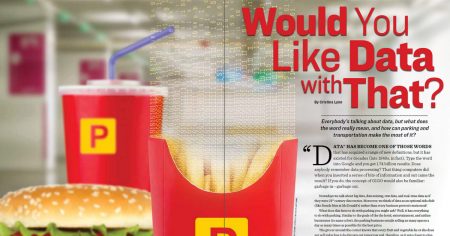Introduction
“Data” has become one of those words that has acquired a range of new flavours, notwithstanding it has existed for decades (late 1940s in fact). Type the word into Google and you get 1.74 billion results!! Does anybody remember “data processing”? That thing that computers did whereby you inserted a series of bits of information and out came the result? If you do, the concept of GIGO would also be familiar: garbage in – garbage out….
Nowadays we talk about Big Data, Data Mining, Raw Data, Real Time Data as if they were a 21st century discovery! And moreover, we think of it as an optional side dish (like French fries at McDonalds) rather than every business person’s main meal!
And what does this have to do with parking you might ask…? Well, it has EVERYTHING TO DO WITH PARKING.
Like the hotel, entertainment and airline businesses, (to name a few) the parking business entails selling as many spaces a day as many times as possible for the best price.
The greengrocer around the corner knows that every fruit and vegetable he does not sell today has to be thrown out tomorrow and therefore, as it gets closer to closing time, he might drop the price to encourage budget conscious customers to purchase them. At this point of the day, any revenue is better than none!
Similarly, a vacant car space at any time of the day represents a lost revenue opportunity.
How does a car park owner manage this and know if he/she is achieving his/her business objectives? THAT, is the role of data!
What is car park data?
Car parking data encompasses a wide range of information ranging from the number of cars spending a specific period of time in a car park (length of stay by time band), to the number of transactions by type of parker (casual, permanent, early bird), to revenues generated. This can refer to an hour,a day, a week, a month or a year and can be compared to prior periods to analyse trends and set budgets for future periods, just to name a few examples.
Car park data also includes information about how the car park is occupied throughout each 24 hour day and each day of the week. Some car parks are busier during weekdays, others at evenings and weekends. Seasonal impacts and external factors may also affect occupancy. Knowing these trends across a period of time allows a prudent owner to evaluate, for example, the pricing strategies that need to be applied to ensure as many spaces are sold as possible, for the best overall return and to prepare realistic forecasts.
Market forces (demand and supply) will determine the ideal balance which, according to “Shoupian theory” used to sit around 85%. Thanks to technology and improved design, car park occupancy could be expected to consistently reach 95%.
It is not sufficient to analyse car park data in isolation; it needs to be related to the type of business the car park is supporting e.g. an airport, a shopping centre, a hospital, an office building or a university.
An airport for example, should know the % of passengers (or PAX) using the car park (usually known as the “penetration rate”) as opposed to other methods of transport (taxi, train, shuttle bus, drop off, etc.) and how this percentage changes over time, in order to future proof its parking requirements. The growing impact of alternative transport options such as Uber is an important factor to consider when looking at f the requirement for future car parking and how the precinct design should accommodate this growing transport mode. Other airport related KPIs include, for example, car park revenue per passenger and average transaction value split by short term parkers (usually picking up or dropping off someone), medium term (business travellers parking for 1 – 3 days) and long term parkers (holidaying families).
A shopping centre on the other hand, needs to analyse its parking demand in a more granular way analysing length of stay (preferably at half hourly intervals) so as to strike the correct balance between providing a high level of customer service by offering a certain free parking period and the need to discourage abuse of the car park by nearby workers and commuters.
The KPIs for each type of car park need to be identified to ensure the correct information is gathered to measure performance across a range of variables. Large businesses are developing data warehouses which are fed information from various sources (including the car park) in order to assess the overall outcomes.
Where does the data come from?
So where does all this data come from? Essentially it is gathered by the access control equipment installed in the car park, whereby each time a customer takes a ticket, makes a payment at the APS and exits the car park the information is stored in the management system. Similarly every time a tenant uses their swipe card to enter and exit a transaction is generated. Further transactions are recorded via online booking systems or by the use of loyalty cards issued by the operators.
More information is available from parking guidance systems which are able to record each time a vehicle uses a specific bay in the car park and for how long. This level of granular information was unimaginable only a few years ago when it was necessary to use survey staff to manually record information on a spreadsheet (with the consequent risk of human error). Heat maps generated by the PGS system identify areas within a car park that are particularly busy or popular and those which have low levels of utilisation.
Malfunctions in the equipment, as well as alerts to action specific tasks (e.g. clear ticket jams, replenish change hoppers in the APS machines, etc.) also generate data in the system that tracks the number of times specific items of equipment break down or need attention. Most interestingly from a revenue perspective is the number of times barriers are raised manually by on-site or remote personnel, as this may result in lost revenues.
There is a whole raft of other data that also needs to be collected. Intelligence about nearby competitors regarding pricing and levels of presentation is important to ensure that pricing strategies and competitive advantages are identified and maintained over time.
Customer surveys are another key component of data gathering. How often do we make decisions on the basis of what we think the customer wants without actually bothering to ask them?
These types of “soft” data need to be collected on a regular basis to identify changes in trends and potential threats appearing on the horizon.
How often does the owner of a commercial building survey its tenants to understand how the demand for parking within the building may be changing? Is there a growing need or demand for other services? Bicycle parking and end of trip facilities are now being incorporated into new buildings or retrofitted in existing ones. Are there other alternative uses for unwanted parking spaces? Remember, unused parking bays are like those unsold fruit and vegetables!
What data does the customer need?
As far as the customer is concerned, the most important information relates to finding an available parking space in the quickest possible way. It is generally accepted that drivers spend an unreasonable amount of time searching for a parking space and this can be either on street or inside car parks. Notwithstanding the available technology, it is still not usual (except for retail centres) to see a display showing the number of available bays in a car park prior to entering. Just the other day I drove into a car park in a busy Sydney suburb on a Saturday evening to find that the car in front of me was reversing up the entry ramp as he had realised that the car park was full. The sign installed outside that should have been illuminated to indicate this information was not turned on!
Even more unusual in Australian cities and town centres is the application of guidance systems that direct drivers to available parking spaces across the range of parking options (whether privately or publically owned) usually located in the periphery of the centre with easy and convenient road access.
Also important for the customer is information about pricing. Casual drive up parking rates are advertised on operators’ websites for the various categories (hourly, early bird, evening, weekend, etc.) and with the widespread use of online booking engines cheaper parking may be available at specific times and days. It is essential that parking fees are regularly reviewed by the operator and the owner with reference to changes in prices in the surrounding car parks and car park occupancy to ensure that pricing levels are competitive and all opportunities for maximising utilisation of the car park are seized.
What about the owner?
It is the car park owner that benefits from having information readily available in the correct format in order to make relevant operational, marketing, financial and strategic decisions. Whether the portfolio comprises one or many car parks determines the level of information required.
Under a lease scenario, the owner generally relinquishes all operational duties and limits himself to collecting an agreed rental each month. Unless a turnover rent component is included in the lease, there is very little data provided by the operator to the owner as effectively the business carried out in the car park is owned by the lessee.
Often, the owner relinquishes the operation of the car park to an external party who is then charged with managing the property to the mutual advantage of the owner and themselves. If the arrangement involves a management agreement, the operator manages the car park on behalf of the owner for a fee, with the owner being involved (to various degrees) in all the main decisions regarding operations, pricing, staffing, technology, marketing initiatives, etc. The management agreement provides the framework for the respective duties of the operator and the owner including responsibility for the relevant costs with the operator providing monthly reports to the owner containing the relevant “data”.
Owners need to take a proactive approach to obtaining and analysing the car park’s performance data, not just at the time when agreements are being renewed or tendered, but throughout the life of the asset. Advances in technology, for example, may result in reducing or eliminating on site staff, with a resulting reduction in operating costs. Changes in the external environment (new or refurbished car parks nearby, changes to public transport or traffic circulation) may have an impact on the car park’s performance which could not have been foreseen when the agreement was entered into.
If the reporting requirements have been correctly identified and documented in the agreement then it should be possible for the owner to access and study the information and be in a position to discuss the results with the operator so that appropriate measures can be implemented to maximise the car park’s results.
Thanks to a well thought-through process of reporting and regular meetings, the owner and the operator can work together to achieve mutual objectives.
What is the data of the future?
As parking access systems develop from hardware to software platforms, the type of data available may change and may affect how it can be verified. Audit trails of transactions generated from other sources such as CCTV cameras or Apps will need to be defined to provide the car park owner with the necessary level of assurance that the revenues are being correctly and fully reported and maximised.
The increasing use of electric cars in our roads will provide an opportunity for car park owners to expand their customer base to these vehicles. The decision of if, and if so, how many charging points to incorporate into the car park, will need to be based on analysis of trends of purchases of electric cars and incentives that may be offered by the public sector to encourage the switch. Other data that will need to be managed includes information about how driverless vehicles will affect people’s driving (and parking) habits and in what timeframe. This also applies to the growing use of Ubers and other emerging shared vehicle options. Owners will need to consider how these changes will affect future car park developments from a design point of view.
In conclusion
As new “disruptors” challenge our industry it will be really important for owners to measure performance closely so that appropriate actions can be undertaken both to manage revenues and control expenses.
Data is a means to an end; it is a tool that management uses to make better decisions. We have all heard the expression “paralysis by analysis”; a Forbes contributor (Jeff Boss) has this to say:
“What, then, do you do in today’s world where there is so much information to navigate? After all, trying to stay up to date with the latest viewpoints and updates is akin to the human version of an information hamster wheel: you can run along it all day but never actually arrive anywhere.”
The first step is to define the KPIs that will provide insight into the car park business performance as well as its relationship to the business it supports.
The next step is to identify the source of the data needed to calculate those KPIs and how that data is going to be gathered and audited. Is this a task delegated to one or more operators managing various car parks in the owner’s portfolio or will the owner develop its own business intelligence software? The answer to this question requires pros and cons to be clearly identified. Within our ever changing technological environment there are now tools such as dynamic pricing which allows operational decisions to be made to affect not just profitability but also maximise efficiency, reduce congestion and change people’s habits.
Regardless of the outcome, the data (or more importantly the KPIs) will need to be reviewed on a regular and timely basis, compared against budgets, evaluated against changing market forces and acted upon as necessary.
This article was published in The Parking Professional magazine, July 2018. Download the PDF version of this article:




